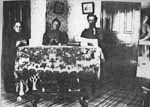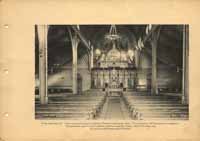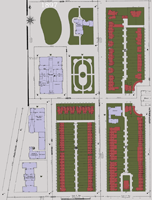Area Churches
You are at Home -> The Town of Pullman -> Area ChurchesArea Churches in 1900
List compiled by Janice Helge- All Saints (Episcopal) -- 1883
- First Swedish Baptist Church of Pullman (Bellevue Baptist)
- Bethel Baptist (1891 - met in Arcade - see 1st Roseland Baptist)
- Bethesda Evangelical Free Congregational Church of Pullman
- Elim Lutheran Church
- 1st Swedish Baptist Church of Pullman -- 1882
- 1st Swedish Methodist Episcopal Church of Pullman (Roseland Methodist)
- Pullman Methodist
- Holy Rosary (Irish) (1882 - Market Hall)
- Pullman Christian Reformed Church
- Pullman Presbyterian
- Roseland Evangelical Lutheran Free Church (1885 - met in the Arcade)
- St. Stephen's Methodist Church
- Swedish Baptist Church -- 1888
- Swedish Ev. Mission Church (Arcade)
- Swedish Methodist (Arcade)
The Greenstone Church
The exterior of the Greenstone Church is of serpentine limestone quarried in Pennsylvania. The sanctuary is unchanged with the exception of the chancel arrangements. All of the cherry wood is original. Pullman intended that the building be rented to the various denominations on a shared basis under one pastor. The idea did not succeed. The rent of $300 per month for the church and $65 for the parsonage to the south were deemed excessive. The original cost of the building was $57,000. It will seat 600. The building was consecrated in 1881 by The Rev. Dr. James Pullman (a brother) from the Universalist Church of Our Savior in New York. The building stood empty for some time because the various religions could not agree to share its facilities. The Presbyterian congregation eventually worshipped there until the property was sold to the Methodists in 1906. It is somewhat ironic that the Methodists came to own the building, for it was the Methodist minister, John Carwardin, who emerged in 1894 as one of the front line advocates of the workers' cause in the Pullman strike. It was his data collection and writings that provided documentation for the legal consideration that led to the State Supreme Court ruling in 1896 that ordered the Pullman Company to divest itself of the all property not related to its state manufacturing charter. The pipe organ, built in 1882 by the Steere and Turner Company of Springfield, Mass., (one of the finest organ builders of the nineteenth century) is one of the few manual tracker action organs still remaining in the United States. It was originally powered by hand-operated bellows, later by a water powered motor, and now by an electric blower. This was the only modernization of the instrument. That the organ is largely in its original condition and has had relatively little repair over the past hundred years shows the high quality of the materials and workmanship. A tracker action organ is one in which the valves that supply air to the individual wind chests and pipes are linked to the stops and keys respectively and are directly activated by the organist's hands or feet. Organists unused to this find playing the Greenstone organ physically demanding. The west Rose window has been restored with funds raised by the community. Most of the glass is original. The window was designed by Beman. Beman was later commissioned to create designs for the Swedish Elim Lutheran Church and Holy Rosary Church -- these two buildings are still standing on 113th St. west of the elevated Metra Electric tracks.Images of the Greenstone Church
Swedish Elim Lutheran Church

More Information...
Images of area churches
THE PULLMAN HISTORY SITE

More Information About the Town of Pullman
Planning the town
The Arcade Journal
The Hotel Florence
The Arcade
Arcade Park
The Stables
Market Hall
Area Churches
Area Schools
The Freight Depot and the Railway Station
Other Pullman Buildings
The Pullman House History Project

Arranged by:
Name
Address
Occupation
Birthplace
People of Color
Maps of Pullman
Images of the Town of Pullman
All images of the town
Vistas
Art & Architecture
- Landscape architect Nathan Franklin Barrett
- Architect Solon Spencer Beman
- Henry Koopman and Family, Photographer
- Landscape Design
Pullman’s Neighborhood
- The Calumet River
- IHACCR
- Area Churches
- The Kensington Neighborhood
- Lake Calumet
- North Pullman
- The Roseland Neighborhood
Buildings in Pullman
- The Arcade Building
- Arcade Park
- Carriage House
- Casino Building
- Fire Department
- Freight Depot
- Gas Works
- The Hotel Florence
- Hospital
- Houses
- Market Hall
- Schools
- Stable
- Train Station
Other Pullman-Related Sites
- Historic Pullman Garden Club - An all-volunteer group that are the current stewards of many of the public green spaces in Pullman. (http://www.hpgc.org/
- Historic Pullman Foundation - The HPF is a non-profit organization whose mission is to "facilitate the preservation and restoration of original structures within the Town of Pullman and to promote public awareness of the significance of Pullman as one of the nation's first planned industrial communities, now a designated City of Chicago, State of Illinois and National landmark district." (http://www.pullmanil.org/)
- The National A. Philip Randolph Pullman Porter Museum is a 501(c)3 cultural institution. Its purpose is to honor, preserving present and interpreting the legacy of A. Philip Randolph, Pullman Porters, the Brotherhood of Sleeping Car Porters and the contributions made by African-Americans to America's labor movement. ((http://www.nationalpullmanportermuseum.com/)
- Pullman Civic Organization - The PCO is a strong and vibrant Community Organization that has been in existence since 1960. (http://www.pullmancivic.org/)
- Pullman National Monument - The official page of the Pullman National Park. (https://www.nps.gov/pull/)
- South Suburban Genealogical & Historical Society - SSG&HS holds the Pullman Collection, consisting of personnel records from Pullman Car Works circa 1900-1949. There are approximately 200,000 individuals represented in the collection. (https://ssghs.org/)
- The Industrial Heritage Archives of Chicago's Calumet Region is an online museum of images that commemorates and celebrates the historic industries and workers of the region, made possible by a Library Services and Technology Act grant administered by the Illinois State Library. (http://www.pullman-museum.org/ihaccr/)
- Illinois Digital Archives (IDA) is a repository for the digital collections libraries and cultural institutions in the State of Illinois and the hosting service for the online images on this site. (http://www.idaillinois.org/)














